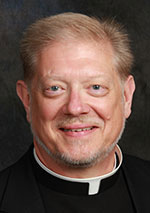That All May Be One / Fr. Rick Ginther
Festival of Faiths to highlight religions’ history in state
 The Festival of Faiths is one means by which people of various religions gather to focus upon a “oneness” which binds all believers: our search for God and God’s meaning in our daily lives, cultures and customs.
The Festival of Faiths is one means by which people of various religions gather to focus upon a “oneness” which binds all believers: our search for God and God’s meaning in our daily lives, cultures and customs.
On Sept. 18, the Fourth Annual Festival of Faiths will take place.
From 1-5 p.m. at the Veterans Memorial Plaza in downtown Indianapolis (north of the Indiana War Memorial between Meridian and Pennsylvania streets), many people of faith will gather.
Sponsored by the Center for Interfaith Cooperation (CIC—go to www.centerforinterfaithcooperation.org), the “Indy Festival of Faiths” is an annual gathering in downtown Indianapolis designed to recognize, highlight and celebrate the diverse religious landscape in central Indiana. A primary goal of the festival is to heighten awareness about the many religious congregations that coexist in our community. … [T]he festival provides an opportunity to share and learn about each other’s traditions in a very open and public setting.”
The 2015 festival drew more than 2,000 visitors. They mingled among the booths of more than 100 congregations, community organizations, universities and food and merchant vendors.
Indiana is celebrating its bicentennial this year. To help celebrate this event—and use the opportunity to increase interfaith understanding—each participating religion will highlight its religious history in Indiana.
The Archdiocese of Indianapolis has been a festival partner since the inaugural event in 2013. Participating archdiocesan offices have varied from year to year. This year, our exhibitors will come from the Office of Ecumenical and Interreligious Affairs and the Indiana Catholic Conference.
The first diocese in the history of the state, the Diocese of Vincennes, which later became the Archdiocese of Indianapolis, was established in 1834, 18 years after the state was founded. But the Church still had a strong presence in the state long before 1816.
French missionaries ministered to the first Catholics in the Northwest Territory. Because of their herculean efforts, Catholic settlers found support for their spiritual lives. The settlers thrived and survived, forming small communities of faith. From these arose the Diocese of Vincennes.
Catholic schools attached to local parishes soon began to dot the state. The Sisters of St. Benedict (first in Ferdinand, and later, in Beech Grove), the Sisters of St. Francis (Oldenburg), and the Sisters of Providence (Saint Mary-of-the-Woods), among others, founded and staffed these schools.
Institutions of higher education opened to serve the local population. Saint Mary-of-the-Woods-College (1840), the University of Notre Dame (1842), St. Mary’s College (1844), Marian College [now Marian University] (1851), Saint Meinrad Seminary and School of Theology (1857), St. Joseph’s College (1889), the University of St. Francis (1890), Ancilla College (1937), Calumet College of St. Joseph (1951), and Holy Cross College (1966) began their mission of education.
Catholic hospitals sprang up to meet the needs of any citizen. Among these are St. Mary (Hobart), St. Elizabeth (Lafayette), St. Vincent (Indianapolis), and St. Francis (Indianapolis). Nearly all of these now have multiple locations, serving thousands of folks each year, especially the poor and needy.
St. Vincent de Paul Societies and Catholic Charities also flourished to support the needs of the total population of our state.
We as a Church are part of the broader community in our state. Having read some of what our Church has contributed to Indiana, come to the festival to see what so many other faiths have to contribute to our life and history. See you on Sept. 18!
(Father Rick Ginther is director of the archdiocesan Office of Ecumenism. He is also dean of the Terre Haute deanery and pastor of St. Patrick and St. Margaret Mary parishes, both in Terre Haute.) †
 The Festival of Faiths is one means by which people of various religions gather to focus upon a “oneness” which binds all believers: our search for God and God’s meaning in our daily lives, cultures and customs.
The Festival of Faiths is one means by which people of various religions gather to focus upon a “oneness” which binds all believers: our search for God and God’s meaning in our daily lives, cultures and customs.